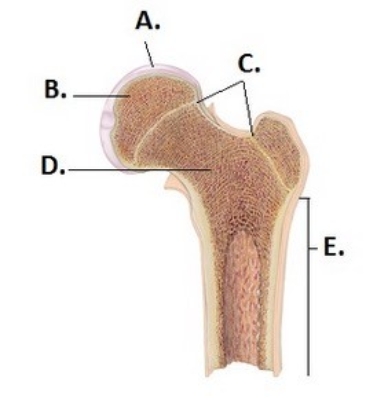A) Spongy bone
B) Diaphysis
C) Epiphyseal lines
D) Articular cartilage
E) Epiphysis
G) B) and D)
Correct Answer

verified
Correct Answer
verified
Multiple Choice
How does the nervous system contribute to homeostasis in individuals suffering from osteoporosis?
A) Address inadequate amounts of calcium and vitamin D in the diet.
B) Stimulate exercise to reduce muscle stress on bone.
C) The sense of pain following injury helps prevent further injury.
D) Inhibit blood clotting to halt the repair process.
E) Reduce calcitonin secretion.
G) A) and C)
Correct Answer

verified
Correct Answer
verified
Multiple Choice
Which of the following membranes covers the surface of a mature bone?
A) Perimysium
B) Perichondrium
C) Peritendineum
D) Peritoneum
E) Periosteum
G) A) and C)
Correct Answer

verified
Correct Answer
verified
Multiple Choice
Important functions of the skeletal system include
A) protection of the brain and soft organs.
B) storage of water.
C) production of Vitamin E.
D) regulation of acid-base balance.
E) integration of other systems.
G) A) and D)
Correct Answer

verified
Correct Answer
verified
Multiple Choice
Sally has elevated blood calcium levels. Which substance would you expect to find in high levels in response to this condition?
A) Growth hormone
B) Sex hormones
C) Parathyroid hormone
D) Calcitonin
E) Vitamin D
G) A) and E)
Correct Answer

verified
Correct Answer
verified
Multiple Choice
The flat bones of the skull develop from ________.
A) hyaline cartilage
B) areolar tissue
C) compact bone
D) fibrous connective tissue
E) fibrocartilage
G) D) and E)
Correct Answer

verified
Correct Answer
verified
Multiple Choice
The most common bone disease is osteoporosis. The most common consequence of this disease is
A) fractures.
B) bone thickening.
C) luxations and subluxations.
D) fusion of bones.
E) remodeling of bone.
G) B) and C)
Correct Answer

verified
Correct Answer
verified
Multiple Choice
The processes of intramembranous and endochondral ossification are similar in several respects. Which of the following statements applies to both intramembranous ossification and endochondral ossification?
A) Both processes form woven bone.
B) Both processes require a precursor of connective tissue membranes.
C) In both processes, bone replaces cartilage.
D) Both only form flat bones.
E) Chondrocytes participate in both processes.
G) A) and C)
Correct Answer

verified
Correct Answer
verified
Multiple Choice
Which of the following is true of the condition osteomyelitis? (Check all that apply.)
A) It is caused by the normal skin bacterium, Staphylococcus aureus.
B) The condition involves inflammation of the bone, which is stimulated by osteoblasts releasing the chemical RANKL.
C) Osteoclasts are inhibited by the bacterium that causes the condition.
D) Prognosis for those affected is poor, even with excellent medical care.
F) B) and D)
Correct Answer

verified
Correct Answer
verified
Multiple Choice
Arrange the following events of endochondral ossification in the proper sequence: (1) Cartilage matrix is calcified and chondrocytes die. (2) Chondrocytes hypertrophy. (3) Cartilage model is formed. (4) Osteoblasts deposit bone on the surface of the calcified cartilage of the primary ossification center. (5) Blood vessels from the periosteum invade calcified cartilage bringing in osteoblasts and osteoclasts.
A) 3, 2, 1, 5, 4
B) 3, 2, 5, 4, 1
C) 3, 2, 5, 1, 4
D) 3, 5, 2, 4, 1
E) 1, 3, 4, 5, 2
G) C) and D)
Correct Answer

verified
Correct Answer
verified
Multiple Choice
 -What does structure "E" represent on the bone diagram?
-What does structure "E" represent on the bone diagram?
A) Spongy bone
B) Diaphysis
C) Epiphyseal lines
D) Articular cartilage
E) Epiphysis
G) C) and D)
Correct Answer

verified
Correct Answer
verified
Multiple Choice
Which of the following cell types is responsible for breaking down bone matrix?
A) Chondroclast
B) Osteoclast
C) Chondroblast
D) Fibroblast
E) Osteocyte
G) A) and D)
Correct Answer

verified
Correct Answer
verified
Multiple Choice
Identify the components of the skeletal system. (Check all that apply.)
A) Bones
B) Cartilage
C) Ligaments
D) Muscles
E) Tendons
G) A) and C)
Correct Answer

verified
Correct Answer
verified
Multiple Choice
When blood vessels become surrounded by concentric lamella forming osteons, the bone will grow in ________.
A) length
B) diameter
C) the epiphyseal plate
D) the articular cartilage
E) All of the choices are correct.
G) A) and C)
Correct Answer

verified
Correct Answer
verified
Multiple Choice
The radiologist informs Matthew that his fracture has not penetrated the skin, meaning Matthew has a/an ________ fracture.
A) open
B) closed
C) displaced
D) composite
E) irregular
G) D) and E)
Correct Answer

verified
Correct Answer
verified
Multiple Choice
Name the air-filled spaces lined by mucous membranes found within flat and irregular bones.
A) Foramina
B) Medullary cavities
C) Sinuses
D) Short bone
F) A) and C)
Correct Answer

verified
Correct Answer
verified
Multiple Choice
Osteomyelitis is
A) bone inflammation that often results from bacterial infection.
B) a disease in adults, especially women, characterized by a reduced amount of bone matrix.
C) a disease in adults characterized by softening of bones resulting from calcium depletion.
D) a disease in children characterized by soft, bowed, and swollen bones.
E) a group of genetic disorders producing very brittle bones that are easily fractured; occurs because of insufficient collagen development.
G) A) and B)
Correct Answer

verified
Correct Answer
verified
Multiple Choice
Which type of bone cell is a large cell that forms from fusion of several precursor cells?
A) Osteochondral progenitor cell
B) Osteoblast
C) Osteocyte
D) Osteoclast
F) A) and B)
Correct Answer

verified
Correct Answer
verified
Showing 161 - 178 of 178
Related Exams